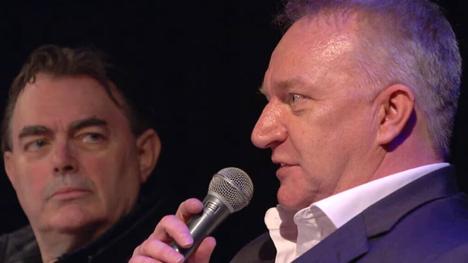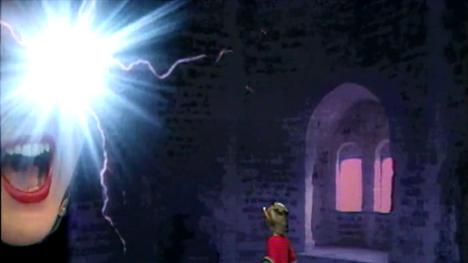Computer Images Magazine, which ran from the mid-to-late 1980s, examined how Knightmare was made after Series 1.
Knightmare in 1987
Firstly, the idea of Knightmare 'the living computer game', comes from Tim Child. He presented a micro computer program for Anglia Television in the early 80s. He had the idea of a computer game based game show.
The original idea was that the contestants would play against each other on a number of popular computer games. Later he had the great idea of having the contestants "in" the computer game. This was developed into Knightmare. Tim Child developed a lot of the details in Knightmare, he was involved in the scripts and the design of the virtual sets. He supervised at every level of the creation of Knightmare, it was very much his program all the way along.
The actual computer technology that was used was provided by Robert Harris's company Travelling Matte. This was basically a Mercedes truck filled with computer equipment that could travel around the country to where it was required. Robert Harris had previously been the head of computer graphics for BBC East, before leaving to form his own company. Before that he had spent 10 years designing sets for a variety of programs. He did the computer graphics that were used on the Hitchhiker's Guide to the Galaxy.

Most of the graphics were drawn by a team of illustrators, props were mostly built as models, they worked from sketches that detailed how the individual rooms and props should look. The completed illustrations were then scanned into the Spaceward Supernova paint system computers using a Sony scanner. The graphics could then be edited and special effects/animation added.
Lighting conditions were added by the computer, many rooms were used more than once but were made to look different by giving them different lighting conditions. Many of the monsters and props, whether they were created on the computer or from illustrations were stored in the computers. They could be added to the scenes before the game started, or they could be called up while the show was being played. In the first series the camera angles were fixed. There were plans to make it possible to have multiple camera angles in a later series.
The computers were used to edit the scenes while the program was being filmed, as often what happened in the scene was dependant on the players actions. The rooms were almost completely empty, they used the "Blue room" technique. All the sound was dubbed on later, but the control team who ordered around the player (through a microphone in the helmet) saw what was happening in real time. This included effects such as close ups, the "falling" animation, the life force, etc.
The computers that were used were Spaceward Supernova Paint Systems. These were Motorola 68020 based systems (the same processor used in the Amiga 1200, Mac LC&II, and late model Sinclair QLs). They had 12MB RAM, and 600MB hard disk. The systems were controlled using a graphics tablet which corresponded to the systems screen. The whole OS and its programs were controlled by a number of pull-down menus, these were marked on the graphics tablet. The package used to create Knightmare was called Ultimate.

I believe Spaceward were based in Cambridge, or at least had a research centre there. I am not sure what happened to the company, I know that they were accused of stealing another company's ideas and were taken to court over it. Maybe that was enough to destroy the company. I believe that in a later series a Silicon Graphics system was used for some of the effects, and possibly the title sequence. But it was still all put together by Travelling Matte.
Mary Whitehouse (a well-known moralist) led a campaign to stop Knightmare, she felt that the program could damage young minds. The "popular press" picked up on it and there were a few unfavourable stories in the press about Knightmare. The "moral minority" felt that Knightmare was too violent and scary for young children. They also felt that the contestants shouldn't "die" when they lose. The producers of Knightmare had to agree to tone it down in the next series.
The graphics team that did Knightmare went on to work for British Satellite Broadcasting. They went to work on a Knightmare spin off set on a killer satellite, it was to be called 'The Satellite Game'. It was going to be a leap forward for the "living computer game" concept. Basically the plot was that a big satellite (called Enigma) had entered the solar system, and gone into orbit around Jupiter. It was going to blow up and destroy all life in the solar system unless a team of kids entered it and smashed its core. To get to the core they would have had to do a load of puzzle rooms, using the Knightmare formula (a couple of people ordering around someone in a blindfold).

The plan for The Satellite Game looked very ambitious for the day. They were planning to use robotics, lasers, 3D computer animation, multiple camera angles, etc. It was broadcast on the BSB's Children's Channel.



